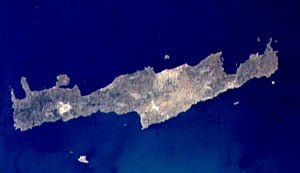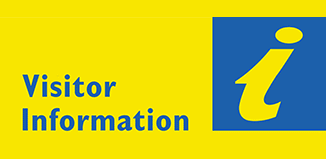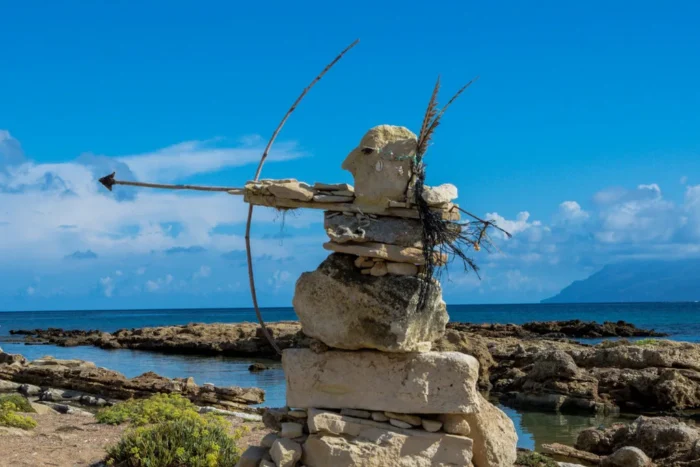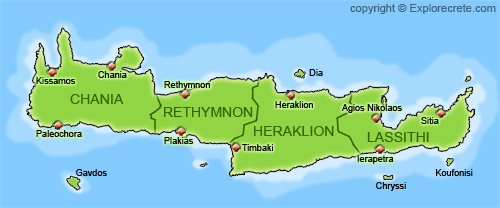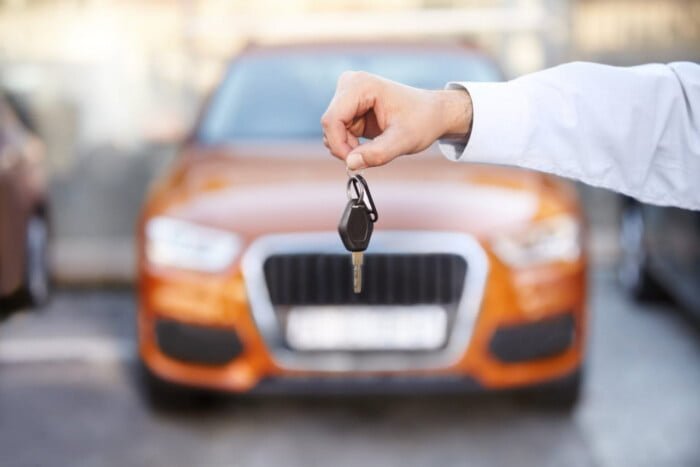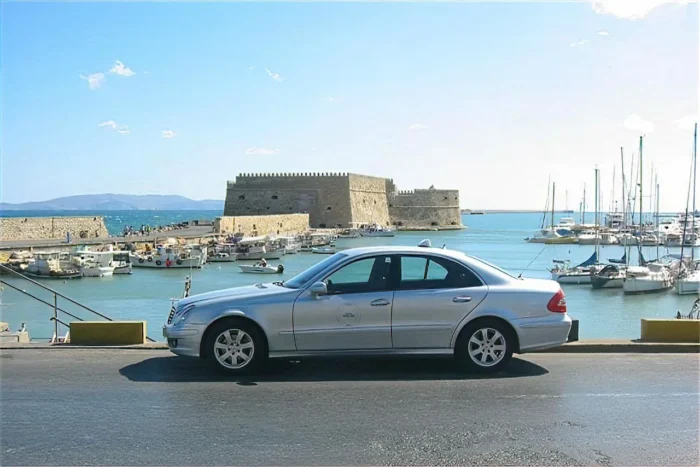Driving in Crete, road conditions and tips
Driving in Crete might seem a daunting prospect at first. However, provided you take appropriate care your trips will be safe and result in enormous pleasure. To give you a head start on some of the local conditions, take a look through the following.
Table of Contents
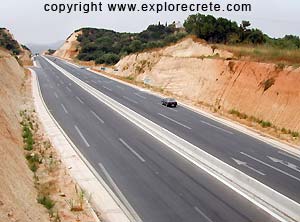
The condition of the roads in Crete
The roads in Crete and Greece vary in their quality and state of repair. Major cities are generally connected by wide highways, smaller ones by lesser roads.
In northern Crete there is a highway from Agios Nikolaos to Kastelli (Kissamos) via Heraklion, Rethymnon and Chania. The part from Agios Nikolaos to Sitia is still narrow and has many sharp bends.
In many parts the highway, or National Road as it is known in Crete, is a dual carriageway road. A continuous program of improvement and maintenance means that the dualling is being extended all the time. (NOTE. A dual carriageway is a road where the different directions are separated in some way, by a strip of grass or barriers . There are usually two lanes in each direction).
New, wider roads are also constructed to Messara area in southern Heraklion district (Festos, Matala, Timbaki, Kokkinos Pirgos), as well as the Viannos area.
Driving in the South of Crete
Away from the north coast the situation changes radically and the roads become narrow and can have blind bends. If you want to reach the most remote areas, then you may find some of your trip may include roads with long gravel stretches.
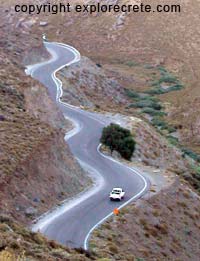
This is also common in the mountainous areas, where new dirt roads are being created all the time and where road warning and direction signs may not be present. It is important not to attempt a mountain crossing if you do not have detailed and recent instructions from the locals. Some mountain roads are only suitable for 4WD vehicles.
Narrow winding roads can often mean that journey times are rather longer than might be expected from distances calculated from a map. For example, the distance from Paleochora to Sougia is about 30 km but it takes almost 45 minutes to get there because of the very narrow road and the way it winds its way up and down the mountains.
Crete is a mountainous island and driving can yield spectacular views but traveling on it’s winding roads can also be a cause of motion sickness. If you are traveling with small children make frequent stops and allow extra time to get to your destination.
Rules for Driving in Crete – Unofficial Tips
Driving in Greece is on the right, the same as in the United States and most of Europe. Vehicles coming from the right have the right of way unless otherwise posted. This means that cars entering a traffic circle go first, drivers already in the circle must yield.
If there is little room to pass on the road, fast drivers expect slow drivers to pull onto the hard shoulder in order to let them by. Be aware though that the hard shoulders can end suddenly and that they may also be obstructed by rock falls. (NOTE. Hard shoulder is the emergency lane, which in Crete is very narrow).
Traffic signs throughout Greece are generally in Greek and English, and Greece uses internationally recognized traffic control and stop signs.
Parking is permitted along most city streets, but vacant places may be difficult to find. In some areas you have to buy and use a Parking Card, which can be bought at a nearby kiosk (periptero).
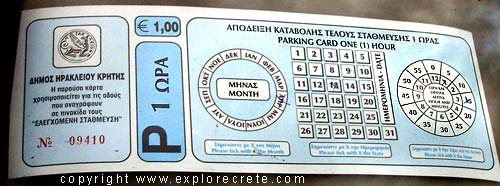
Here is a parking sign that you may find confusing:

Do not park in this side of the street during odd months of the year (month 1, 3, 5,…)

Do not park in this side of the street during even months of the year (month 2, 4, 6,…)
Use of a vehicle’s horn in towns is allowed only in cases of immediate and extreme danger.
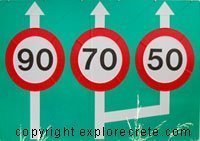
Speed limits in Crete are as follows: 50 km per hour (30 mph) in built-up areas and 90 kph (56 mph) on the highway. There are road signs informing you about the speed limits, which vary from one area to another, even without any obvious or logical reason. There are spots along the north highway where the road is good, straight and with very good visibility ahead but suddenly a road sign indicates a low speed limit. These are the favourite spots of the police for a traffic check.
Alcohol tests are frequent and strict and the limit is 0,50 mg. Do not expect to be let off a traffic offence just because you are a tourist. You have to pay fines at the tax office in the area where the “ticket” is issued, so if people are on a days excursion they must make paying part of the day’s activity or, if they return to their base on another part of the island, it will require another trip to the area specially to pay
Emergency Line for Visitors to Greece
There are no emergency telephone devices along the highway in Crete. In case of an emergency you should use your cell phone.
Dial 112. The number 112 is the same emergency number as found in other European countries and it is a toll-free 24 hour line. Callers to 112 will be able to receive information in English, French and Greek regarding ambulance services, fire brigade, police and the coast guard. Operators will stay on the line in case the tourist requires translation assistance.
Emergency roadside help and information may be reached by dialing 104 for vehicle assistance and towing services, 100 for police, 166 for an ambulance, and 199 for the fire brigade.
The Automobile and Touring Club of Greece provides 24-hour information to foreign motorists regarding driving in Greece , by dialing 174.
Another reliable road assistance company is Express Service, dial 154
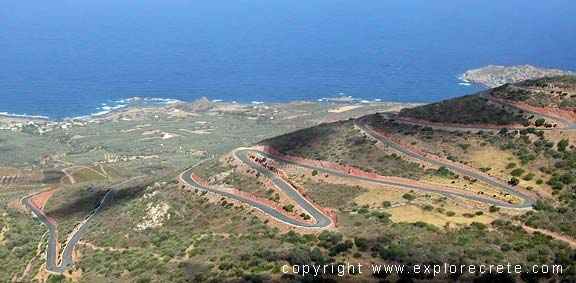
Hints for safe driving in Crete
While you drive in a town, pay particular attention to mopeds. Moped riders tend to overtake on the right instead of the left as they should. Even if you leave enough space for them to pass from the left, they are so addicted to passing from the right, that they will do anything to achieve their preferred mode of overtaking!
If you notice in your mirror an approaching car flashing its lights at you, the driver is usually asking you to move to your right to allow him to overtake.
Drive extra carefully on Saturday nights! The reality is that too many people will be out, drinking more than they should when driving, and will drive dangerously as a result.
While you drive in a town, be aware of pedestrians walking in the street. Often the sidewalks are narrow or non-existent and people cannot avoid walking in the street.
A few Greek drivers forget to use their indicators to signal an intention to make a turn. Try and develop a sixth sense to predict what they may be about to do in the absence of an indication. Expect the unexpected!
The quality of asphalt road surfaces is not always good as road surfaces are affected by a number of factors including floods and rock falls in winter, and extreme heat in summer. Pot holes and loose gravel surfaces are very common as a result. This makes some roads particularly hazardous for motorcyclists.
Goats are everywhere in Crete and they like to feed next to the road. It is not uncommon to see a few of them walking in the road, even around a main highway.
If you visit Crete in the winter, then pay extra attention if you drive on a very rainy day as rocks may have been dislodged and fallen onto the roads. A small pile of stones at the side of the road often indicates that the surface under the asphalt has been eroded at that point and should not be driven over.
Do not place absolute trust the white lines marking the lanes in the highway. Occasionally, a lane may end suddenly and without warning. It is commonplace to see drivers crossing double white lines.
Maps are not reliable when it comes to remote areas. If you doubt which direction to go, then look for a local and ask for instructions. People of Crete are helpful and they will do their best to assist you.
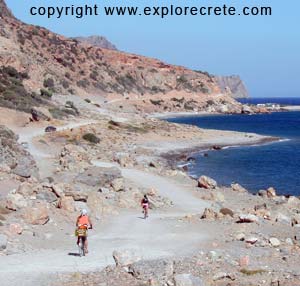
Some road signs are small and you will see them only if you drive slowly and look carefully. Example: the first exit to Rethymnon when you drive from Heraklion. Do not expect big signs hanging above the road as in European highways.
As you drive around Crete you will hopefully quickly get a feel for the roads and will soon get an idea of what forms the ‘unexpected’ can take. You will soon decide that you will need to have traveled a road fairly recently before you can start to open up a little. As well as tourists, you will from time to time find a farmer etc who may not be expecting much other traffic, or who can’t find the indicator or light switches readily. No problem though if you are thinking ahead. Part of the beauty of Crete is that the pace of life is generally far more relaxed than in many other places and to some extent, that pace is applied by some to the roads at times.
Particular points for Motorcyclists
It is common to see young tourists on motorbikes or mopeds dressed in shorts and tees or even their swimsuits without a helmet on. Add a few beers to this and you get a lethal combination.
The unpredictable condition of the road surface (pot holes, rock fall debris, etc) need extra attention. Though there is some fine motorcycling to be had in Crete, you may well find you have to change your style of riding to stay safe. If you do not always expect the unexpected, you will soon have a wake up call.
Particular points for cyclists
Bicycles are rare in Crete. The reasons are the warm climate and the mountainous landscape with the steep inclines and descents. Drivers are not used to finding their roads used by bicycles.
Pedestrians can be more dangerous than cars to the cyclist. They don’t feel threatened by bicycles and tend to step off the sidewalk into the street suddenly and stand right in front of you.
Particular points for Pedestrians
Visitors must beware of motorbike drivers when crossing streets as they often weave in and out of traffic lanes and crowd intersections at traffic lights.
If there is no sidewalk you will have to walk in the street. Be very careful when you do so.
If you need to cross the road be very careful especially in areas with a lot of traffic like Amoudara in Heraklion or Platanias and Agia Marina in Chania. Don’t bother to walk far down a street looking for official crossing points, there usually aren’t any. In the few places that pedestrians’ crossings do exists, do not expect many drivers to take notice of them and allow you precedence.
Roadside memorials
A common sight in Crete are the small metal or stone constructions at the sides of the roads, often in the form of a miniature church. These are memorials for people killed in a car accident and they are located at the exact spot where the accident occurred.
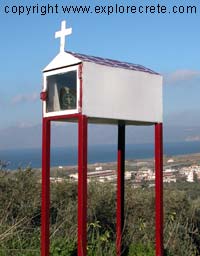
They are constructed by the family of the deceased and inside there is usually a photo together with some religious objects. The families visit them often, clean and maintain them and light the candles. They exist in all different kinds of shapes and materials used.
Common Greek Words
- Alcohol test = alkotest (e as in egg)
- Bicycle = pothilato (th as in this)
- Car = aftokinito
- Car license = thiploma (th as in this)
- Car mechanic = mihanikos aftokiniton
- Drive = othigo (th as in this)
- Driver = othigos (th as in this)
- Gasoline = venzini
- Gas station = venzinathiko (th as in this)
- Highway = ethniki othos (th as in “ethniki”, th as in throne, in “othos” as in this)
- Insurance = asfalia
- Moped = mihanaki
- Motorcycle = mihani, motocikleta (e as in egg)
- Pedestrian = pezos (e as in egg)
- Police = astinomia
- Policeman = astinomikos
- Police ticket = klisi
- Road = thromos (th as in this)
- Road bend = strofi
- Road sign = pinakitha (th as in this)
- Speed = tahitita
- Speed limit = orio tahititas
- Street = thromos, othos (th as in this)
- Traffic lights = fanaria
- Traffic police = trohaia
- Traffic policeman = trohonomos
Car Parts in Greek
- Brakes = frena (e as in egg)
- Car = aftokinito
- Door = porta
- Gas pedal = gazi
- Gear stick = mohlos tahititon
- Hand brake = hirofreno
- Hit the brakes = frenaro
- Horn (noun) = korna
- Horn (verb) = kornaro
- Lights = fota
- Luggage = aposkeves
- Seat = kathisma
- Steering wheel = timoni
- Tires = lastiha
- Window = parathiro (th as in throne)
- Windscreen = parmpriz
Instructions
- How shall I go to …? = Pos tha pao sto …?
- How far is …? = Poso makria einai to …?
- Where is a gas station? = Pou ehei benzinathiko?
- I need a car mechanic = Hriazomai mihaniko gia to aftokinito
- Turn right / left = Stripse theksia / aristera (th in “theksia” as in this)
- Drive straight = Pigaine efthia
Links and Notes :
- Read about the new motorway constructed in Crete: The longest highway in Greece will be in Crete!
- The usefulness of roads became obvious for central authorities which, when powerful enough, developed real road networks. Crete for instance had a small road network at its disposal in the 2nd millennium BC. The Minoan cities were connected with stone roads, formed from blocks cut with bronze saws. Streets were drained and water and sewage facilities were available to the upper-class, through clay pipes.
© explorecrete.com All Rights Reserved. Reproduction or copying without permission is prohibited.

